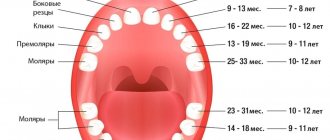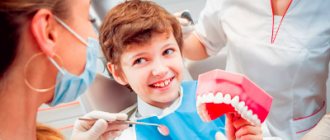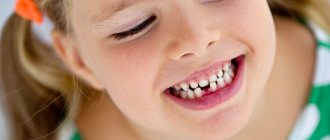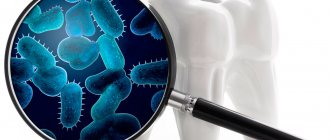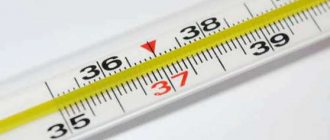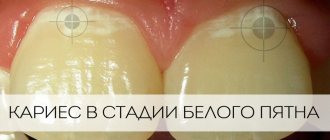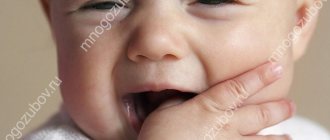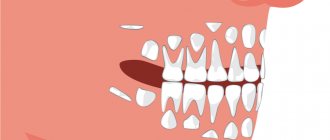Many parents still think that pediatric dentistry is needed only for exceptional cases: if the child has a severe toothache and the pain does not go away on its own. There is also an opinion that there is no need to do anything with baby teeth, because they will fall out anyway and give way to molars. These are erroneous opinions that the doctors at our clinic would even call dangerous.
Why does a child need a pediatric dentist? First of all, for preventive examinations and monitoring the growth of teeth and their replacement. The health of baby teeth is influenced by many factors. In turn, the health of the first teeth affects the condition of the molars even before they erupt. Next, we will understand how the change process occurs. Every parent should know this to help their child get straight, beautiful teeth and not experience problems in adulthood.
If you are still not used to taking your child to the pediatric dentist once every six months, it’s time to write down the date of the next visit on your calendar and make an appointment with us at the clinic in advance. This simple action will help prevent unpleasant problems and have a positive effect on the formation of the bite and the condition of the oral cavity.
In addition, early acquaintance with the doctor will help children form a good impression of the clinic. They will associate dental care at Mira children's dentistry in Krasnoyarsk with something festive and exciting! This is absolutely the opposite of the situation when you bring a child to the clinic with a severe toothache that requires treatment. A visit to the dentist will inevitably be remembered as something unpleasant.
Why do temporary teeth fall out?
The process of changing elements of the dentition does not happen just like that. The appearance of the first teeth occurs between the ages of 6 and 9 months, when children begin to eat not only mother's milk, but also denser foods. At the same time, the dimensions of the maxillofacial apparatus are small, and therefore the dimensions of the first teeth are quite compact. Over the years, primary teeth are no longer able to perform chewing functions properly, and the jaw enlarges. As a result, it is able to accommodate all molars.
What affects malocclusion?
- genetic predisposition;
- infectious diseases of the mother at the stage of gestation;
- artificial breastfeeding of the baby (use of pacifiers, bottles with nipples);
- habit of thumb sucking;
- mouth breathing, habit of walking with an open mouth, gothic sky;
- mechanical injuries;
- incorrect dental prosthetics in the past;
- loss of one or more teeth;
- late dental implantation.
Approximate timing and sequence of shifts
According to a large number of parents, the process of changing primary teeth begins when children lose their first tooth, which usually occurs at the age of about 6-7 years. But this is a wrong opinion, because this process begins long before this moment. After reaching the age of 4, children's third molars, which are molars, emerge. It is from this moment that the countdown begins.
Around the same time, the roots of primary teeth dissolve, which takes up to 24 months. During the resorption of root tissues, the baby tooth begins to wobble, and by the time the permanent ones appear, the corresponding element of the dentition is pushed out.
The sequence of teeth changing is approximately the same as the order in which they erupt. First, the central lower incisors fall out, after which a similar change of upper teeth occurs. Then the lateral incisors, first molars, canines and large molars are gradually replaced. The change of the first milk tooth and the loss of the last one can occur at different ages; the differences can reach 2 years. According to some experts, girls lose their baby teeth earlier than boys.
The table shows an approximate schedule for the replacement of temporary teeth with molars.
| Baby teeth | Beginning and duration of dissolution of the root of a temporary tooth | Age |
| Central lower incisors | From 6 years (within 24 months) | 6-7 years |
| Central upper incisors | From 6 years (within 24 months) | 6-7 years |
| Lateral lower incisors | After 6 years (within 24 months) | 7-8 years |
| Upper lateral incisors | After 6 years (within 24 months) | 7-8 years |
| Small (first) upper molars | From 7 years (within 36 months) | 8-10 years |
| Small (first) lower molars | From 7 years (within 36 months) | 8-10 years |
| Upper canines | From 8 years old (for 36 months) | 9-11 years |
| Lower canines | From 8 years old (for 36 months) | 9-11 years |
| Large (second) lower molars | After 7 years (within 36 months) | 11-13 years old |
| Large (second) upper molars | After 7 years (within 36 months) | 11-13 years old |
Which teeth should an eight-year-old child have?
Every child who has reached the age of eight should normally have the following permanent teeth - 4 lower and 4 upper incisors, sixth molars. Sometimes there may be individual deviations in teething within plus or minus six months.
Why is it necessary to treat caries in childhood if you then have to remove baby teeth with filled roots?
If an empty space forms in the dentition, this contributes to the fact that the remaining milk teeth shift, and along with them, the rudiments of permanent teeth also shift and they begin to grow incorrectly under them - in one place the formation of cracks begins, and in another - the teeth fit alone another. A filled, treated baby tooth will save space for a permanent tooth. Untreated teeth infect the rudiments of permanent teeth with infection, which causes their deformation and even complete absence.
Nutrition during the period of changing baby teeth
The enamel of the molars is not fully formed when they erupt. This process lasts several years, so a nutritious diet with properly selected products is of great importance:
- Every day the child should eat food containing large amounts of calcium (milk and dairy products).
- In some cases, if the baby does not want to consume dairy products, it is recommended to take vitamins with a high calcium content.
- Fruits and vegetables, some of them should be consumed in solid form in order to more quickly dissolve milk roots and erupt molars.
- It is recommended to include fish dishes containing phosphorus in your diet twice a week. It is better to give children low-fat varieties, including pike perch, hake and pollock.
- Eliminate chocolate, white pastries and sweets from your diet. Sweet soda is considered the most dangerous for tooth enamel.
During the change of baby teeth, it is necessary to avoid the consumption of sticky or hard foods, including toffees, nuts and candies. Otherwise, you can damage the temporary tooth or cause it to fall out too early, which often causes problems in the growth of permanent teeth. In addition, children should not eat food that contains active dyes, which can negatively affect the color of the enamel of permanent teeth without the possibility of further changing it.
What causes baby teeth to fall out?
Before permanent teeth appear, interesting physiological changes occur, such as the spontaneous resorption of the roots of baby teeth. This is why they begin to wobble and fall out. The germs of permanent teeth are located between the roots of milk teeth, because of this, resorption begins from the place where the root adheres to the germ of a permanent tooth. Resorption starts from the apex of the root and gradually moves towards its base. As soon as this process approaches the neck, the tooth falls out.
Children erupt 20 baby teeth. In the oral cavity, adults have from 28 to 32 teeth. Typically, all baby teeth fall out. In a child by the age of 14, they should be completely replaced by permanent ones.
Care instructions
Since the enamel is not yet fully formed during the eruption of molars, great attention should be paid to proper oral hygiene and preventive measures to prevent the development of caries.
- In the morning and evening, teeth should be brushed using a soft brush that does not damage the gums. Children are recommended to use special toothpastes with a high content of calcium and fluoride. It is better to brush your teeth under adult supervision, as children often do it too quickly and not thoroughly enough.
- All children should visit the dentist twice a year for an examination, professional cleaning, and timely detection and treatment of tooth decay.
- After any meal, children should rinse their mouths with plain water, a special baby mouthwash, or chamomile infusion. Thanks to this, plaque will not accumulate on the teeth and the likelihood of developing an inflammatory process in the eruption zone of the molar will decrease.
Consequences of incorrect bite
- tooth decay - abundant carious lesions, inflammation of the gums, dynamic formation of hard and soft plaque, general unsatisfactory condition of the oral cavity;
- dysfunction of swallowing, facial expressions, speech;
- breathing problems, snoring;
- diseases of the ENT organs, as well as the gastrointestinal tract;
- facial asymmetry, violation of external aesthetics. The result is self-doubt, complexes, and psychological blocks.
Premature loss
This refers to the loss of baby teeth when the child has not yet reached the age of 6. Causes may include caries, special loosening and mechanical damage. If a tooth falls out long before the molar begins to grow, a space will appear in the oral cavity that will later be occupied by the remaining teeth. Eventually, permanent teeth will begin to erupt unevenly due to lack of space.
If you experience early tooth loss, you should contact an orthodontist. Often today, in such situations, prosthetic technologies are used, the main task of which is to prevent the displacement of other elements of the dentition. This solution helps prevent the development of malocclusion and the appearance of various visual defects.
What to do when teething?
The first teeth erupting will cause discomfort in the child, and this is a natural process. During this period, salivation increases, and a runny nose may occur due to the eruption of the upper teeth. The normal pace is for new teeth to appear every few weeks.
Be prepared for the fact that the child will be capricious and refuse to eat, and his temperature may rise. To make this period easier, you can use special teething toys. During this period, the gums become inflamed and cause discomfort - they can itch and hurt. Talk to your dentist: There are safe cooling gels for children that can help reduce the intensity of teething and teething symptoms in children.
It is also recommended to replace drinks with plain water. Juices and other drinks that contain sugar create an acidic environment in the mouth. Because of this, an inflammatory process may begin. Care should be taken to disinfect pacifiers and toys that children may put in their mouths.
The first teeth appear at the age of six months. The first chewing teeth appear between the ages of 1 and 1.5 years. Fangs are cut between the ages of 2 and 2. After this, by the age of 3, the following chewing teeth appear. Each new group requires attention. Thus, it is important to brush your chewing teeth well after eating, since the enamel of baby teeth is quite weak. Retention of food on the surface can easily cause inflammation.
It is also important to ensure that the child weans the habit of the pacifier and stops putting his fingers in his mouth. If this does not happen, an incorrect bite will be formed.
Replacement too late
In some cases, the molars are already erupting, although the milk teeth are not yet loose. Often this also leads to the appearance of certain defects. The solution to the problem is to visit a specialist to remove a baby tooth.
It also happens that molars do not appear in the standard time frame. In this case, temporary teeth may be present or fall out. Reasons for this phenomenon:
- Physiological factor. The development of tooth germs occurs properly, but their growth is too slow for certain reasons.
- Retention of molars. The tooth germs are formed in a timely manner, but the location of the permanent tooth inside the jaw bone tissue is incorrect.
- Partial primary adentia. During the development of the child inside the mother's womb, the proper laying of the rudiments did not take place or their death occurred due to inflammation.
To detect such defects and determine the exact reasons for untimely replacement of baby teeth, a specialist uses x-ray examination, which allows us to determine the characteristics of the formation of tooth germs. If developmental defects are detected, children are prescribed temporary prosthetics for the period of active jaw growth. After reaching a certain age, permanent dentures are installed.
Formation of periodontium and roots
This stage of development begins after the eruption of permanent teeth and usually lasts for 3.5-5 years. It includes the development processes of surrounding tissues, as well as the root system. At the same time, the crown of permanent teeth at this stage is almost completely formed and is ready for active mineralization after eruption.
The period of development of the root part and periodontal tissues is divided into the following stages:
- active growth of the tooth root in length;
- development and strengthening of the root apex;
- uncovered root tip;
- formation and strengthening of periodontium;
- completion of periodontal and root development.
Role of parents
In most cases, changing primary teeth does not cause any particular difficulties. But if a child complains of discomfort in the gums, you can use gels that have an analgesic effect, for example, Dentinox or Kalgel.
If instead of a baby tooth there is a wound on the gum that is bleeding, you can apply a ball of sterile cotton wool to it and hold it for about 5 minutes. After a temporary tooth falls out, it is forbidden to eat food for 2 hours. On that day, it is better not to give your child spicy, salty or sour foods.
If a molar has already broken through, but the baby tooth has not yet fallen out, it is better to use the help of a dentist rather than remove it yourself.
Various types of pathological bite
According to statistics, up to 80% of people have various malocclusions
Mesial occlusion (progenia)
The presence of a mesial bite , characterized by an anterior position of the lower jaw relative to the upper jaw, can often be determined even visually - by the protruding lower jaw.
Deep bite
Holders of a deep bite , in which the incisors of the upper jaw overlap the incisors of the lower jaw by more than a third, can be visually distinguished by a deep mental fold and a shortened lower part of the face.
Distal bite (prognathia)
The external manifestation of a distal bite, in which the upper incisors are located far ahead of the lower ones, is the upper jaw unnaturally pushed forward.
Crossbite
A crossbite is characterized by a narrowing of the lower or upper jaw with a displacement of the lower jaw to the side. An external sign of such a defect is pronounced facial asymmetry.
Open bite
With an open bite, the teeth of the upper and lower jaws do not contact each other in some area.
During the period of changing baby teeth you cannot:
- Pull or loosen teeth yourself.
- Chew hard candies and nuts.
- Use metal or sharp objects as toothpicks.
- Use hydrogen peroxide, alcohol and other strong antiseptics to cauterize wounds.
The timing of the replacement of primary teeth is considered very individual. The number of simultaneously fallen elements of the dentition and the duration of this period depend on many factors. It is not recommended to speed up the process. At the same time, the appearance of various deviations is a reason to contact a dentist.
Correction of bite with braces
Structurally, such a system consists of arches connected by special locks - braces, fixed on the surface of the teeth.
One of the most common and effective orthodontic techniques is bite correction with a braces system. Structurally, such a system consists of arches connected by special locks - braces, fixed on the surface of the teeth. Due to the tension created by the arches, the teeth are shifted in the required direction and fixed.
Today, various braces systems are successfully used
- Metal,
- Sapphire,
- Ceramic,
- Lingual (installed on the inside of the dentition),
- Self-ligating (providing the most gentle and physiological correction of the position of the teeth).
The choice of a specific type of brace system is made individually for each patient.
Teething symptoms
Since the process of teething begins simultaneously with the loss, it is always a huge stress for a fragile child’s body. Not every child tolerates everything easily - there is general lethargy, moodiness, mood swings, loss of appetite due to painful sensations in the mouth. Other symptoms are possible:
- runny nose and prolonged nasal congestion;
- swelling of soft tissues, swelling moving to the face;
- unnaturally strong salivation;
- cough;
- indigestion - diarrhea or prolonged constipation;
- rash around the corners of the mouth;
- increase in body temperature.
A common mistake young parents make is that, having discovered one of the listed symptoms, they begin to treat their baby for a cold or food poisoning, instead of seeking help at the clinic. As a result, the child receives a dose of unnecessary medications, and the general condition does not improve in any way, because the root cause has not been eliminated.
Bite correction using the Invisalign system
One of the newest types of removable structures are transparent aligners of the Invisalign system.
One of the newest types of removable structures are transparent aligners of the Invisalign system . This treatment method involves manufacturing a set of special thin and transparent aligners for the patient using high-precision equipment. All mouthguards have slight differences in shape. The patient wears each one for approximately 14 days and then changes to the next one. As a result, the teeth gradually shift in the required direction, and the bite approaches normal.
